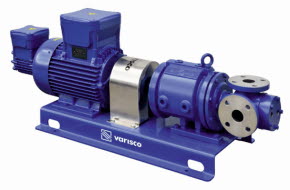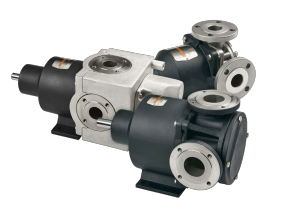AxFlow can supply both internal gear pumps and external gear pumps



Internal Gear Pumps
2 series from 2 manufacturers
Gear pumps use the actions of rotating gears to transfer fluids. The rotation develops a liquid seal with the pump casing and creates suction at the pump inlet. Meaning that Fluid drawn into the pump is enclosed within the cavities of its rotating gears and transferred to the discharge.
OPERATING PRINCIPLE OF INTERNAL GEAR PUMPS
Internal gear pumps operate based on the interaction between two interlocking gears—an outer gear and an inner gear — within a housing. The key operating principles of internal gear pumps involve.

GEAR INTERACTION
Internal gear pumps consist of an outer gear with external teeth and an inner gear with internal teeth. These gears rotate together, with the inner gear being smaller and positioned inside the outer gear. As they rotate, the gear teeth mesh, creating cavities that trap and move fluid from the suction port to the discharge port.
FLUID MOVEMENT
As the gears rotate, fluid is drawn into the pump through the suction port. The expanding cavities between the gear teeth create a low-pressure zone that draws in the fluid. As the gears continue to rotate, the meshing of gear teeth reduces the cavity size, compressing and displacing the fluid towards the discharge port.
FLUID SEALING
The gears maintain close tolerances with the pump housing, ensuring minimal leakage between the suction and discharge sides. This design results in positive displacement, which means a consistent volume of fluid is displaced with each revolution of the gears.
FLOW CONTROL
The flow rate is proportional to the speed of rotation. Controlling the speed of the gears enables fine-tuning of the flow rate, allowing for precise control over the fluid delivery.
APPLICATIONS OF INTERNAL GEAR PUMPS
- Asphalt & Bitumen Production: Effective in handling sticky substances in large-scale production.
- Chemical Industry: Used for precise metering and transferring of ingredients.
- Oil & Gas Sector: Reliable in high-pressure applications.
- Food & Beverage: Ensures accurate transfer and metering of ingredients.
IMPORTANT CONSIDERATIONS WHEN SELECTING INTERNAL GEAR PUMPS
- Flow Rate: Selecting the right internal gear pump involves considering the desired flow rate. Insufficient flow rates may lead to poor performance, while excessive rates can cause pressure issues and inefficiencies.
- Viscosity: Internal gear pumps handle a wide viscosity range. Lower viscosity fluids move more easily, while higher viscosity fluids may require adjustments to gear speed for proper handling.
WHY BUY INTERNAL GEAR PUMPS FROM AXFLOW?
AxFlow provides a diverse range of internal gear pumps tailored to various industries. Our experts offer comprehensive support, aiding in pump selection, specification, installation, and maintenance. Reach out to AxFlow for personalized guidance in choosing the ideal internal gear pump for your specific requirements.
- AxFlow offer a wide range of internal gear pumps including internal and external types, mag driven versions and plastic and alloy wetted materials.
- We are experts in gear pumps having supplied them for over 40 years.
- We have a large team of external and internal pump specialists, and a network of Pump Support Centres spread across the country.
ADVANTAGES OF GEAR PUMPS
Gear pumps are unable to match the pressure capabilities of reciprocating pumps or the flow rates of centrifugal pumps but offer higher pressures and throughputs than vane or lobe pumps. Gear pumps are particularly suited for pumping oils and high viscosity fluids. There are 2 types of rear pump internal and external both offer the same generic advanatges.
- A smooth flow.
- Low flow capabilties.
- Compact footprint.
- Easy maintenance.
- Can handle viscous fluids.
- Can run at low speeds.
- Self priming.
- Low cost.
- Low Shear
| Application | Internal | External |
| Chemical additives,mixing and Blending |
|
|
| Soaps and surfactants |
|
|
| Alcohols and solvents |
|
|
| Acids and caustic (stainless steel or composite construction) |
|
|
| Glycol |
|
|
| Food Production |
|
|
|
|
|
|
|
|
||
|
|
|
|
|
Industrial and mobile hydraulic applications (log splitters, lifts, etc.) |
|
|
|
Low volume transfer or application |
|
|
|
Resins and Polymers |
|
|
|
Polyurethane foam (Isocyanate and polyol) |
|
Internal Gear Pump Maintenance
Maintaining an internal gear pump is important to ensure its efficiency and longevity and can be done in various ways:
-
Routine Inspection: Visual inspection of the internal gear pump and its components in order to identify signs of wear, damage, or leaks.
-
Oil Change: Change the pump's lubricating oil regularly which may be specified by the manufacturer, whilst using the suggested lubricatiing oil.
-
Seal and Gasket Inspection: Inspect seals and gaskets for signs of leaks and wear, and make necessary replacements.
-
Check for Vane Wear: Check the condition of the internal gear pump vanes for wear or damage.
-
Bearing Lubrication: Lubricate bearings as suggested by the manufacturer to prevent excessive friction and wear.
-
Tighten Bolts and Fasteners: Check and tighten any loose bolts, nuts, or fasteners to maintain the pump's structural integrity.
-
Flow Verification: Periodically verify the pump's flow rate and performance to ensure it meets your application requirements.
-
Cleanliness: Keep the surrounding area clean and free of debris to prevent contaminants from entering the pump.
|
SS |
Hastelloy |
Steel |
Duct Cast Iron |
PVDF |
ETFE |
Max Flow m3/hr |
Max Pressure bar |
Gear Type |
Type |
|
|
● |
● |
● |
12.5 |
13.8 |
External |
Mech Seal |
||||
|
● |
● |
● |
12.5 |
69 |
External |
Mag Drive |
||||
|
● |
● |
7.5 |
10.5 |
External |
Mag Drive |
|||||
|
● |
● |
● |
113 |
13.8 |
Internal |
Mag Drive |
||||
|
● |
● |
240 |
16 |
Internal |
Mech Mag Drive |
FAQs regarding Internal Gear Pumps:
How do I select the right internal gear pump for my application?
- Customers tend to seek help choosing the most suitable internal gear pump for their specific needs. This typically results in considerations such as flow rates, pressure requirements, viscosity of the fluid being pumped, material compatibility, and the environmental conditions of the application.
What maintenance practices are recommended for internal gear pumps?
- It is key for customers to be aware of the essential maintenance practices for internal gear pumps, such as routine maintenance tasks, such as checking clearances, inspecting seals, and monitoring the condition of gears, as well as guidelines for troubleshooting common issues.


